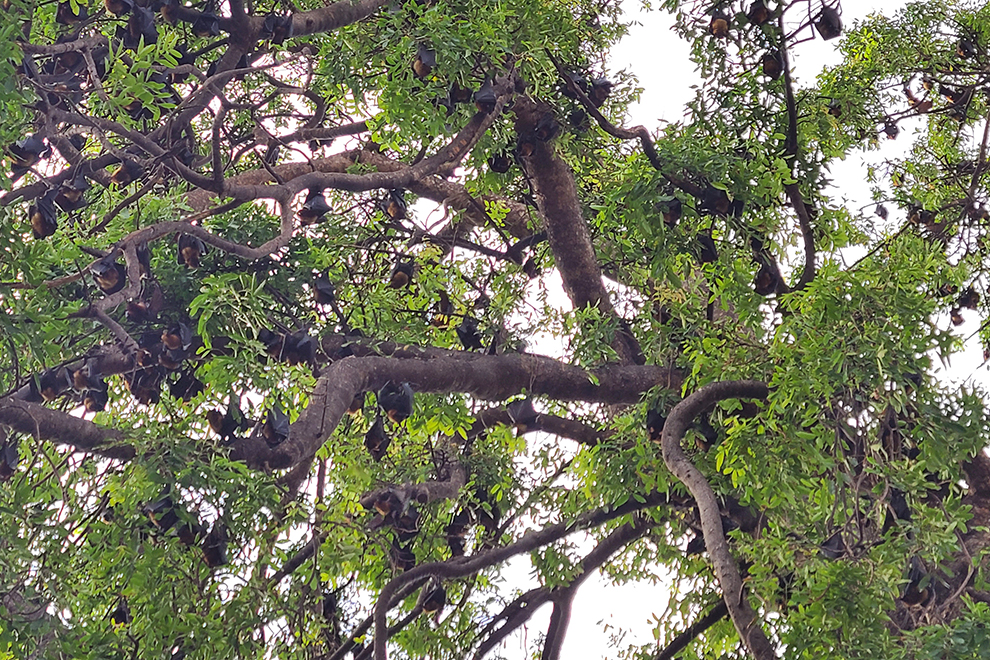
A troop of flying foxes previously seen hanging upside down from a large tree at the Council for the Development of Cambodia (CDC) compound. Hong Raksmey
Phnom Penh’s urban landscape has long been home to a fascinating yet elusive species: the flying fox, whose “sanctuary tree” in the capital is even marked on Google Maps.
These large fruit bats, known for their impressive wingspans of up to 1.5 metres, have made their roosts around Wat Phnom, delighting both locals and international tourists with their nightly flights and their critical role in the local ecosystem.
However, recently, something has changed – an entire troop of these bats seems to have vanished from their iconic perches, leaving many to wonder what happened to them.
For years, visitors to Wat Phnom have marvelled at the spectacle of thousands of flying foxes hanging upside down in the trees surrounding the area. Tourists frequently stop to snap photos of the bats, which are an integral part of the city’s unique environmental landscape.
These bats, with their ability to pollinate key fruits such as durian and longan, play a vital role in maintaining the health of the local ecosystem.
Yet, over the past few weeks, observers have noticed a troubling absence. The large trees that once served as a haven for these winged mammals now stand eerily quiet, their branches devoid of the usual hanging clusters of bats. Local reports suggest that only a few stragglers remain, raising the question: What drove the flying foxes away?

Phnom Penh was once the only capital city in Asia to host a large population of flying foxes in its urban heart, making it an anomaly in the region. Hong Raksmey
Some speculate that the disappearance could be the result of actions taken by local authorities, though no official confirmation has been made.
A commonly held belief among the community is that the flying foxes were perhaps driven out by an increase in development around Wat Phnom or that their habitat was disturbed. A particularly contentious issue is the removal of one of the large trees in the area several years ago, which many believe destroyed an essential roosting spot for the bats.
Chap Dina, deputy governor of Phnom Penh’s Doun Penh district, shed some light on the matter during an interview with The Post.
He dismissed the idea that local authorities had intentionally removed the bats or driven them away. Instead, he explained that their sudden absence could be linked to the behaviour of hornbills, which are known to chase the bats away from their roosts.

Bats play a vital role in pest control, pollination and seed dispersal, directly benefiting local agriculture and natural environments. Hong Raksmey
“These flying foxes have been there for a long time, and no one has harmed them,” Dina stated. “Although they make a little noise and have a particular smell, they were also a beauty of the city that attracted domestic and international tourists.”
In a surprising turn, Dina also revealed that hornbills, a much larger bird species, have been known to chase away not only flying foxes but even pigeons from the area. He said the competition between these species for space in the increasingly urbanised landscape of Phnom Penh may be contributing to the disappearance of the bats.
The flying fox colony near Wat Phnom had long been regarded as one of the capital’s best-kept environmental secrets. Bat expert Joe Ralston, a senior research coordinator for the World Conservation Society (WCS), noted in 1999 that Phnom Penh was the only capital city in Asia to host such a large population of flying foxes in the heart of its urban landscape – making it an anomaly in the region.

The absence of the once-noisy flying foxes, which used to attract tourists, now defines the quiet at the Wat Phnom historical site. Hong Raksmey
“Phnom Penh is the only capital city in Asia with flying foxes in the centre of the city, except perhaps for Rangoon,” Ralston told The Post at the time. However, he also warned of the threats to these bats, citing habitat destruction and persecution in other parts of Southeast Asia.
For the broader scientific community, the flying foxes’ plight raises larger questions about the conservation of urban biodiversity. As Phnom Penh continues to grow, many fear that other species – such as the recently discovered Hayes’ thick-thumbed myotis bat (Myotis hayesi), identified in a 2022 study by Gábor Csorba and Neil M. Furey – could also face similar threats.

The sudden absence of the large fruit bats could be linked to the behaviour of hornbills, which are known to chase flying foxes away from their roosts. Hong Raksmey
This newly discovered bat, which was collected over 20 years ago in Phnom Penh, highlights the importance of protecting the city’s remaining green spaces. Raising awareness about the importance of bats in urban ecosystems is crucial. Bats play a vital role in pest control, pollination and seed dispersal, directly benefiting local agriculture and natural environments.
“The bat’s distinctive features suggest it evolved to manoeuvre in tight spaces, but ongoing habitat degradation raises serious concerns about its survival,” said Csorba, as quoted by conservation charity Fuana & Flora.










